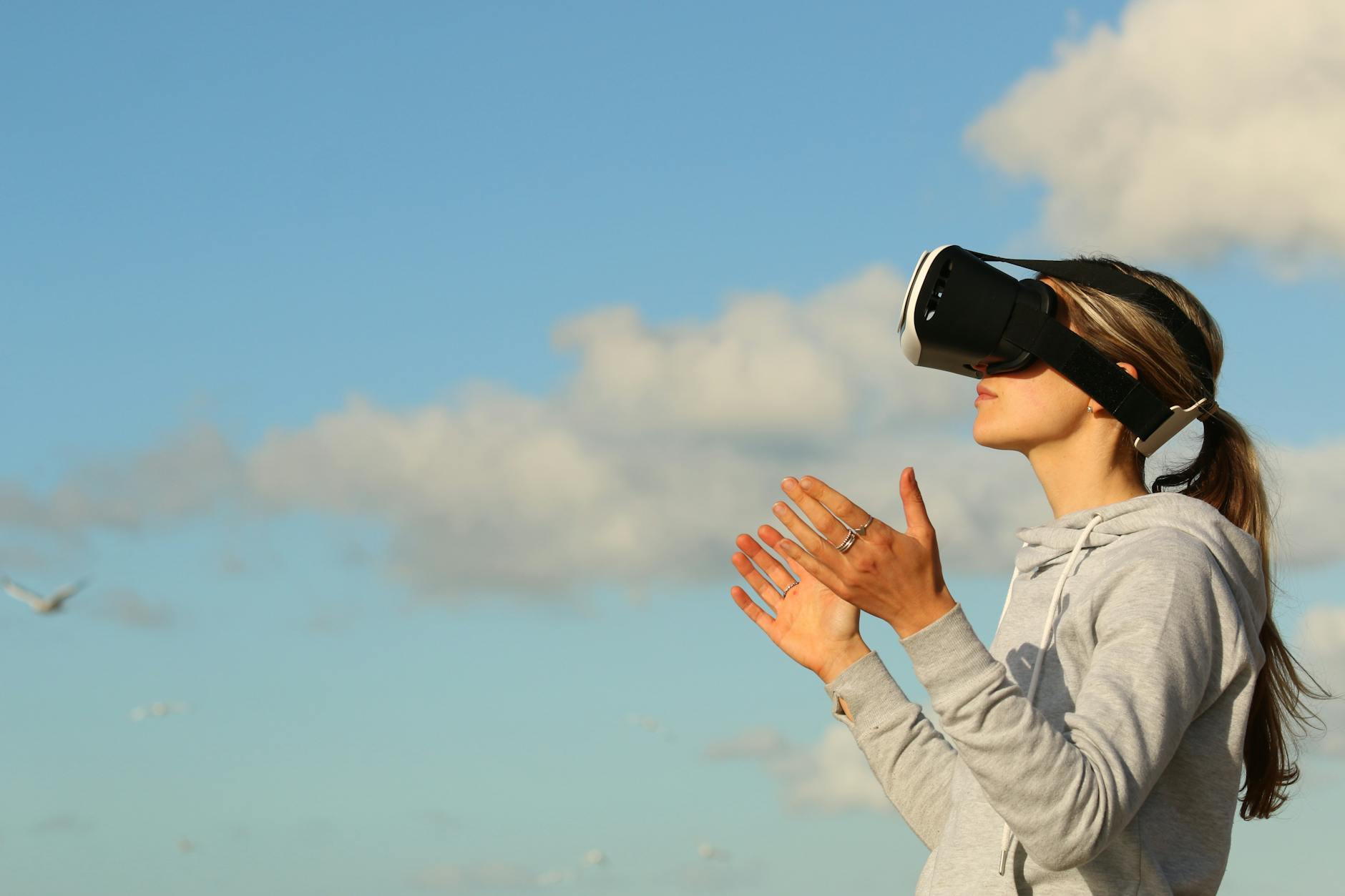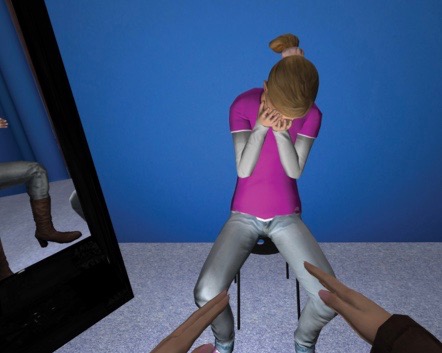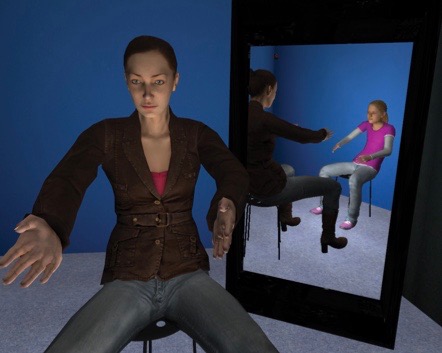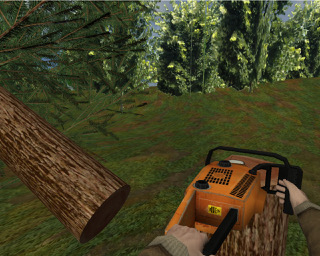Welcome to the Matrix! Opportunities and Risks of the Virtual World
It's been almost 20 years since Neo, "The One", booted up to fight the machines in the global smash hit The Matrix. Once painted as a dark and foreboding frontier,
virtual reality now enables and encourages our full emersion. Is this
field really as threatening as the film, or can people use it for their own psychological fulfilment as easily as Neo is able to download and learn Kung-Fu? These pressing questions remain at the heart of psychological and neuro-scientific research worldwide.
 Picture from Bradley Hook via Pexels.com
Picture from Bradley Hook via Pexels.com
As with The Matrix, everything around us appears real. The Amsterdam harbour, the restaurant, the table at which Jan sits; it's all real life. A young woman sits down.
"Hi, I'm Jan", the man says, a little nervously.
"My name is Marleen", the girl answers. She has a lovely smile. Jan is pleased, though just as he gets used to his blind date, Marleen disappears. Jan hears a voice.
"You started the wrong program, Jan! You're supposed to meet Judith, today."
Jan remembers that Marleen is only virtual, and that next to him sit scientists from the Dutch Delft University of Technology. They ask questions, monitoring Jan's reactions, and even controlling his date to observe his behavior.
The virtual blind date, which according to an experimental study provides a very real sense of nervousness, is one of several scenarios that psychologists have developed for training people to deal with challenging social situations [1].With such situations, researchers hope to answer a question fascinating experts as new technologies develop: Does a visit to virtual reality really change experiences and behaviour in the real world?
How Does the Matrix Look Today?
The modern Matrix, Virtual Reality (or VR) is a computer-generated, three-dimensional space in which users are seamlessly integrated. Special output devices such as head-mounted displays, headphones and joysticks with haptic feedback are all required to make this possible. They block out sensory input from the real world and replace them with virtual equivalents. This is technically referred to as “immersion.”
Immersion is created by continually adapting and syncing the virtual image with the movements of the user. For example, if Jan looks up, the blind date simulation will then migrate his field of vision downwards. Through this immersion, a feeling emerges; one that researches call "presence" - the subjective perception of actually being in another world [2]. In some modern simulations, as is the case in The Matrix, the presence in a virtual world can be so flawless, it is understood as reality. While some fans of the Matrix Trilogy may find that a chilling notion, some are more optimistic: if we can simulate virtual worlds, can we not then train certain skills, and practice them in the real world?
VR Glasses in a Job Interview
Interviews are a delicate situation. As soon as one makes it through the first round, the knowledge that only a few applicants make it all the way sets in. A sense of nervousness builds, and often ends with failure due to anxiety and excitement.
Would it not be preferable to train for the application process from the comfort of one's own sofa? This idea is already being put to work, thanks to British start-up Virtual Speech. With the "Public Speaking VR" app, users can prepare themselves in a virtual room for their next interview. They can make presentations to high-level employers such as Apple, Tesla Motors or Google. What does it feel like to have a virtual interview with Google? I tried it out for myself.
I put on the VR goggles and select the appropriate scenario from an interface. In just a few seconds, I find myself in a bright, windowless room opposite four men and women in suits. They want to know why I'm applying and wish to hear a description of myself. All standard questions, but it soon gets trickier. "How many cities are there in Europe?", ask my virtual counterparts. "Name your favorite Google product, and how you'd improve it." It's hard to produce answers quickly. I get nervous and start sweating. Luckily, I am only a virtual guest at Google. If I were to really go through the Google application process, it’s clear to me: I’ll first practice in the virtual reality environment to get my nervousness under control. But does such a simulation really help to keep calm in real life?
A study from the Netherlands speaks in favor of this [2]: As in real life, pressing questions, rude reactions or rebukes caused anxiety in the virtual interview with the test subjects; their hearts beat faster, their answers became shorter and they reported feeling more tension themselves. This was particularly clear in the case of test subjects who generally had to contend with discomfort during job interviews. Virtual reality was able to compete with the real world here - at least as far as the reactions of the test subjects were concerned. The researchers concluded that VR should be suitable for the realistic training of difficult social situations.
Can we control our fears with VR?
While many of us find it irksome to be under a critical eye, some suffer from real social phobias. About 7% of the population suffers from a disorder in which social or performance-related situations are avoided for fear of negative assessment [3]. It is, however, the immediate confrontation with that fear that provides potential for improvement. The idea to shift confrontations to virtual spaces is an old and established one. As early as 2000, Rothbaum and colleagues showed that a fear of flying can be treated just as effectively with flight simulations as with therapy in the real world [4]. Currently, VR-supported therapy of specific anxiety disorders such as social situations, heights, flight or spiders has proved to be just as effective as classical methods [5][6].
A recent meta-analysis, compiling results from studies of VR therapy, also showed that those affected after a stay in VR not only subjectively felt less anxious, but also experienced fewer psychological restrictions in their daily lives [7]. A particular advantage of VR therapy is its efficiency. Once the program is written, it can be used and reused by many patients. A long-haul flight from Berlin to Moscow is suddenly obsolete.
Free From Depression? How VR Changes Our Emotions.
While some fight their fears out in the world, others struggle daily with a more tenacious obstacle; themselves. They practice harsh self-criticism, failing to overcome a lack of confidence, and sometimes fully sinking into depression. Can VR help these people? To answer this question, a research group at University College London have created an unusual virtual space.
In an experiment, the researchers placed 43 healthy but self-critical women in a virtual body, then gave them the task of comforting a virtual crying child on a chair before them.[8]If they completed the challenge successfully, they would slip into the child's body, and receive the same empathy and compassion that they moments before had given (see pictures below). The results are encouraging: women felt more secure after the virtual experience and reported more compassion towards themselves.

 Giving and receiving compassion in VR. Pictures (adapted) by Chris Brewin via PLOS ONE (http://journals.plos.org/plosone/article?id=10.1371/journal.pone.0111933)
Giving and receiving compassion in VR. Pictures (adapted) by Chris Brewin via PLOS ONE (http://journals.plos.org/plosone/article?id=10.1371/journal.pone.0111933)
The treatment seems to help depressed people too: In a following study [9], fifteen depressive patients first slipped into the role of the consoler, then into the role of the child being consoled; in total three times, each a week apart. These three virtual experiences reduced the severity of depressive symptoms and self-criticism and increased self-compassion - even with a long-term effect: Four weeks after the virtual training, subjects reported themselves thinking less self-critically, and felt more compassionate towards themselves. The results are promising, but the sample was small. Further studies with larger groups of patients need to investigate whether such virtual interventions are an effective means of treating depression.
Being Super(wo)man For Once: Does VR Make Us More Social?
What would you do if a work colleague accidentally knocked their entire box of pens off their desk and onto the floor? Would you rush to help them? Would the situation be the same with a stranger? Whether and how you react is a simple indicator by which psychologists measure prosocial behavior. This is something that can be influenced by exposure to virtual worlds, as a remarkable experiment by researchers at Stanford University shows [10].
In the VR simulation of the researchers, test subjects found themselves in a virtual city - either to explore it for fun, or to search for a diabetic child who urgently needed insulin. There were different roles in both the fun and rescue groups: Some were sitting in a helicopter, others were given the power of flight to search the city like "Super(wo)man". Once the subjects were out of the virtual world and back in the laboratory, a researcher knocked over a box of pens. What looked like an accident to the participants was actually a well-played mistake. The researchers were interested in how the subjects reacted to this mishap - and, above all, whether their willingness to help depended on the purpose or the role they had previously played in the virtual city. Who helps more?
Surprisingly, the instruction to look for the diabetic child had no effect on prosocial behavior: The rescue team was not more helpful than the fun group. The role, however, had an influence: the most helpful ones were the flying superheroes! It did not matter whether they had flown through the virtual city for fun or had been looking for the sick child: On average, they were the fastest to help the clumsy researcher and picked up most of the pens. In this study, the virtual experience of possessing superhuman powers and breaking the laws of physics was able to promote helpfulness - an exciting first result that leaves many questions unanswered, such as whether a virtual Superman experience can having a lasting effect.
Environmental Awareness Through Virtual Tree Felling
From newspapers to packaging to Christmas wrapping paper; according to the Paperless Project [11], an average US citizen at the end of the last decade consumed as much paper as 30 people in Africa. Approximately 68 million trees are cut down every year in the US and turned into paper and paper products under high energy consumption [11]. This damages the environment. Even small changes in everyday life could make an important contribution to environmental protection, such as occasionally taking coffee-to-go in a reusable container instead of a paper cup. But are we really aware of our impact on the environment?
At the University of Georgia, Korean scientist, Sun Joo Grace Ahn, is using VR to demonstrate the effects of everyday behavior on the environment. While the machines in The Matrix used a simulation to remove humanity's awareness of a destroyed world, Ahn seeks to raise awareness of environmental damage. In an experiment she gave subjects a short piece of information about the relationship between deforestation and toilet paper usage [12]. They were informed that about 42,000 trees are felled per day to meet the US population's demand for non-recycled toilet paper. Ahn then transferred some subjects into a virtual forest where they began cutting down trees with a chainsaw (see the picture below). After a tree fell, all ambient sound in the forest was halted. Another group only received a written description of the virtual scenario.
 Cutting trees in VR. Picture from Virtual Human Interaction Lab (Stanford University)
Cutting trees in VR. Picture from Virtual Human Interaction Lab (Stanford University)
Shortly after the end of the experiment, Ahn, supposedly by accident, spilled a glass of water, and asked the test subjects to help in wiping it up. Those who had cut down trees in the virtual space were found to take 20% less paper for the clean up than the subjects in the other control groups. Can the virtual experience of felling a tree really help to avoid the wasting of paper in the future?
To answer this question, Ahn and her colleagues began a second experiment [12]. They once again sent a group to the virtual forest, while another group was simply shown a video, a third one was presented the situation in written form. A week later, the subjects were asked about their environmental attitudes, and of any change in behaviour in their daily lives. The virtual tree felling turned out to be effective again: on average, subjects who had cut down a tree by hand in the virtual forest reported more environmentally friendly behavior - for example, they had bought more recycled paper. Felling the tree with one's own hands apparently conveyed a feeling of control that the protection of forests can be influenced by one's own actions.
Virtual worlds, through more interactive, personal experiences, seem to communicate certain messages more strongly than text or video. Whether the virtual experience can really communicate the impact of felling a tree in real life, the study cannot say.
Although on film, Neo is fighting against the Matrix in order to maintain a grip on reality, VR quite paradoxically is able to open our eyes to very real global issues. Not only are environmental challenges a focal point, with the WWF seeking to convince us of the need to protect wild tigers, but the United Nations is also implementing VR. With three-dimensional videos, a viewer can enter the chaos after the earthquake in Nepal, or can follow the Ganges through the industrially contaminated Kanpur in India [13]. These virtual experiences are having success: The eight-minute video Clouds Over Sidra gives an insight into the everyday life of a young girl in the Za'atri Refugee Camp in Jordan, and has doubled the willingness to donates to UNICEF [14].
Neo's Final Triumph, and the Boundaries of Virtual Space
Today, virtual worlds enable realistic, interactive experiences - even those to which we have no access in the real world: We can experience a plane taking off without being there, self-reflect and answer critical questions in an interview setting, or even inhabit the body of a flying superhero. Diving into virtual worlds can influence attitudes and behavior and have positive effects - for example, combating anxiety.
However, the field is not completely free of the horrors depicted inThe Matrix. Neo is disoriented as he awakens on the Nebuchadnezzar, and continually submits to bouts of panic and nausea as he is exposed to the simulation. Similar symptoms are still prevalent in the real world. Even a brief visit to VR can lead to nausea, dizziness and discomfort. Researchers call this “simulator sickness.” It is assumed that the brain cannot reconcile its own physical standstill with the supposed movement in virtual space, and therefore reacts with unpleasant symptoms.
Virtual worlds can have positive effects - reducing fears and possibly depression, promoting aid and environmental behaviour. But is it at all possible to make significant long-term changes to ourselves, training a desired behaviour in all it's complexity through the use of data goggles? Can every situation be displayed in all details in virtual reality and trained with data glasses? Probably not - or not yet?
In any case, Jan-our virtual blind dater from the beginning of the article- feels the discrepancy between the virtual and the real world. The day of his first real date, Jan rehearses confidently, recalling what he learned in the simulation. Show an interest in her. Ask about her hobbies, and finally, consider when you should meet again. But Karin is not convinced - she simply finds Jan too boring, and his words seem oddly rehearsed. She leaves after 15 minutes, and Jan is left alone to ponder: Perhaps for his next date, he should prepare in the real world instead.
References
[1]Hartanto, D., Kampmann, I. L., Morina, N., Emmelkamp, P. G. M., Neerincx, M. A. & Brinkman, W.-P. (2014). Controlling Social Stress in Virtual Reality Environments. PLOS One, 9 (3), e92804.
[2]Slater, M. & Wilbur, S. (1997). A Framework for Immersive Virtual Environments (FIVE): Speculations on the Role of Presence in Virtual Environments. Presence: Teleoperators and Virtual Environments, 6 (6), 603-616.
[3]Wittchen, H.-U. & Hoyer, J. (Hrsg.) (2011). Klinische Psychologie und Psychotherapie. Berlin: Springer.
[4]Rothbaum, B. O., Hodges, L., Smith, S., Lee, J. H. & Price, L. (2000). A Controlled Study of Virtual Reality Exposure Therapy for the Fear of Flying. Journal of Consulting and Clinical Psychology, 68 (6), 1020-1026.
[5]Meyerbröker, K. & Emmelkamp, P. M. G. (2010). Virtual Reality Exposure Therapy in Anxiety Disorders: A Systematic Review of Process-and-Outcome Studies. Depression and Anxiety, 27, 933-944.
[6]Opris, D., Pintea, S., García-Palacios, A., Botella, C., Szamoskösi, S. & David, D. (2012). Virtual reality exposure therapy in anxiety disorders: a quantitative meta-analysis. Depression and Anxiety, 29 (2),85-93.
[7]Morina, N., Ijntema, H., Meyerbröker, K. & Emmelkamp, P. (2015). Can virtual reality exposure therapy gains be generalized to real-life? A meta-analysis of studies applying behavioral assessments. Behavior Research and Therapy, 74, 18-24.
[8]Falconer, C. J., Slater, M., Rovira, A., King, J. A., Gilbert, P., Antley, A. & Brewin, C. R. (2014). Embodying Compassion: A Virtual Reality Paradigm for Overcoming Excessive Self-Criticism. PLOS One, 9 (11), e111933.
[9]Falconer, C. J., Rovira, A., King, J. A., Gilbert, P., Antley, A., Fearon, P., Ralph, N., Slater, M. & Brewin, C. R. (2016). Embodying self-compassion within virtual reality and its effects on patients with depression. British Journal of Psychiatry Open, 2, 74-80.
[10]Rosenberg, R.S., Baughman, S.L., Bailenson, J.N. (2013). Virtual Superheroes: Using Superpowers in Virtual Reality to Encourage Prosocial Behavior. PLOS One, 8 (1), 1-9.
[11]http://www.thepaperlessproject.com/facts-about-paper-the-impact-of-consu...
[12]Ahn, S. J. G., Bailenson, J. N. & Park, D. (2014). Short- and long-term effects of embodied experiences in immersive virtual environments on environmental locus of control and behavior. Computers in Human Behavior, 39, 235-245.
[13]https://unitednationsvirtualreality.wordpress.com/virtual-reality/overview
[14]Harris, B. J. (2015). How the United Nations is Using Virtual Reality to Tackle Real-World Problems. Verfügbar unter http://www.unicefstories.org/2015/10/13/how-the-united-nations-is-using-... [18.12.2016].

